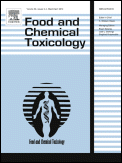
FOOD AND CHEMICAL TOXICOLOGY
Scope & Guideline
Unveiling the science behind food safety and chemical exposure.
Introduction
Aims and Scopes
- Toxicological Mechanisms:
The journal publishes research that investigates the mechanisms through which various substances, including food contaminants and additives, exert toxic effects on biological systems. This includes studies on oxidative stress, inflammation, and cellular apoptosis. - Risk Assessment and Safety Evaluation:
A core focus is the assessment of health risks associated with exposure to chemicals and toxins in food. This includes both qualitative and quantitative risk assessments, often utilizing probabilistic models to evaluate exposure levels and potential health outcomes. - Innovative Methodologies:
The journal encourages the use of innovative methodologies such as computational toxicology, 'omics' technologies, and advanced statistical techniques to enhance the understanding of toxicological effects and improve safety assessments. - Environmental and Dietary Exposures:
Research exploring the impact of environmental toxins and dietary exposures on human health, including studies on heavy metals, pesticides, and mycotoxins, is a significant aspect of the journal's scope. - Biochemical and Molecular Studies:
The journal features studies that delve into the biochemical and molecular alterations caused by toxic substances, including investigations on gene expression, metabolic pathways, and cellular signaling involved in toxicity.
Trending and Emerging
- Nanotechnology in Toxicology:
There is an increasing focus on the toxicological implications of nanomaterials and nanoparticles, particularly regarding their safety in food applications and environmental impacts. Studies are exploring the interactions of nanoparticles with biological systems and their potential health risks. - Endocrine Disruption and Hormonal Effects:
Research examining endocrine-disrupting chemicals (EDCs) and their effects on hormonal pathways is gaining traction. This includes studies on how EDCs impact reproductive health, developmental processes, and metabolic functions. - Food Additives and Contaminants:
Emerging themes include the safety assessments of food additives and contaminants, particularly in light of new regulatory frameworks and consumer awareness. Research is increasingly focusing on the health impacts of common food additives and the need for comprehensive risk assessments. - Microbiome Interactions:
The role of the gut microbiome in mediating the effects of dietary toxins and the implications for human health is an emerging area of interest. Research is exploring how dietary exposures influence microbiome composition and function, and how these changes may affect toxicity. - Machine Learning and Predictive Toxicology:
There is a growing trend towards utilizing machine learning and artificial intelligence in predictive toxicology to assess chemical risks. This includes developing algorithms for predicting toxicity based on chemical structures and biological data.
Declining or Waning
- Traditional Toxicology Studies:
There is a noticeable decline in the publication of studies focusing solely on traditional toxicology assessments without integrating modern techniques such as computational modeling or omics approaches. The journal is increasingly favoring innovative methodologies. - General Food Safety Assessments:
Research that provides broad, non-specific food safety assessments is becoming less frequent. There is a shift towards more targeted studies focusing on specific contaminants or health impacts, suggesting a move away from generalized approaches. - Single Substance Studies:
The prevalence of studies examining the toxicity of single substances without considering their interactions with other chemicals or within complex food matrices appears to be decreasing. This reflects a growing recognition of the importance of cumulative and synergistic effects in toxicology.
Similar Journals

Current Research in Toxicology
Bridging Academia and Industry in ToxicologyCurrent Research in Toxicology is a pioneering journal published by ELSEVIER that serves as a vital platform for disseminating cutting-edge research in the field of toxicology, spanning from biological impacts to pharmacological applications. With an ISSN of 2666-027X and an impressive Q2 ranking in key categories such as Applied Microbiology and Biotechnology, Health, Toxicology and Mutagenesis, and Toxicology, this journal underscores its commitment to high-quality research and significant contributions to the scientific community. Based in the Netherlands, Current Research in Toxicology aims to bridge the gap between academia and industry by providing rigorously peer-reviewed articles that cover a wide array of topics including novel methodologies, regulatory challenges, and emerging trends within the domain. The journal is accessible through various platforms, making it essential for researchers, professionals, and students eager to stay updated on the latest findings and advancements in toxicology. With a comprehensive focus on integrating theory with practical application, this journal is poised to influence future studies and policies in health and environmental science.
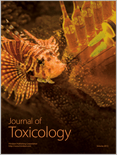
Journal of Toxicology
Innovating safety through cutting-edge toxicological research.Journal of Toxicology, published by HINDAWI LTD, stands as a pivotal open-access journal in the fields of toxicology and pharmacology since its inception in 2009. With an ISSN of 1687-8191 and an E-ISSN of 1687-8205, this journal is dedicated to disseminating high-quality research that critically examines the effects of toxic substances on living organisms. Located in Egypt and operating from their London office, it aims to provide an extensive platform for researchers worldwide to share findings that can inform better practices in safety and regulation. As of 2023, it has achieved significant recognition, holding a Q3 ranking in both the pharmacology and toxicology categories, and is indexed in Scopus with noteworthy percentile rankings (Toxicology: 57th and Pharmacology: 55th). With a focus on innovative studies and emerging areas such as environmental toxicology, biomarker research, and therapeutic interventions, the Journal of Toxicology invites both experienced researchers and students to contribute, thereby enhancing the breadth and depth of toxicological knowledge for the global scientific community.
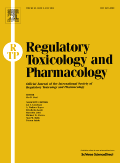
REGULATORY TOXICOLOGY AND PHARMACOLOGY
Pioneering Research for Safer Therapeutics and EnvironmentsREGULATORY TOXICOLOGY AND PHARMACOLOGY is a prestigious peer-reviewed journal published by Academic Press Inc. Elsevier Science, dedicated to advancing knowledge in the fields of toxicology and pharmacology. With an esteemed impact factor and a current ranking of Q2 in both Medicine and Toxicology, this journal serves as a critical resource for researchers, professionals, and students interested in the regulatory aspects of drug safety and environmental toxicology. The journal publishes original research articles, reviews, and regulatory updates that reflect the latest insights and methodologies in safety assessment and toxicological research. Established in 1970, the journal continues to play an integral role in shaping the scientific discourse around regulatory practices in pharmacology, ensuring that both academic and practical perspectives are captured. Readers can access the articles through subscription services, allowing them to stay informed of the most significant developments in the field.

Toxics
Pioneering research in toxicology and environmental health.Toxics is a leading international journal published by MDPI that has been dedicated to advancing the knowledge in the fields of toxicology, environmental health, and chemical safety since its inception in 2013. With an impressive Open Access model, it ensures that all research findings are readily available to a global audience, fostering collaboration and innovation across academia and industry. The journal is esteemed for its rigorous peer-review process and holds notable rankings, including Q1 status in Chemical Health and Safety and Q2 in both Health, Toxicology and Mutagenesis and Toxicology, reflecting its impact on critical research areas. Based in Basel, Switzerland, Toxics provides a platform for researchers, professionals, and students to disseminate significant findings on the implications of toxic substances in health and the environment, aiming to improve public health outcomes and inform regulatory decisions. With its ongoing commitment to high-quality research and relevant access options, Toxics continues to be an essential resource in the domain of toxicology and environmental sciences.

CHEMICAL RESEARCH IN TOXICOLOGY
Bridging chemistry and toxicology for impactful solutions.Chemical Research in Toxicology is a premier journal published by the American Chemical Society, dedicated to advancing the understanding of toxicological effects associated with chemical substances. Since its inception in 1988, this esteemed journal has maintained a robust impact factor, ranking in the Q1 quartile for both Medicine (miscellaneous) and Toxicology as of 2023, reflecting its significance and influence in the fields of pharmacology and toxicology. With an impressive Scopus ranking at #16 out of 133 in the Toxicology category, it serves as a vital resource for researchers, professionals, and students seeking cutting-edge insights and scholarly articles that bridge the gap between chemistry and toxicological science. Although not an open-access publication, it continues to provide comprehensive analyses and original research that inform safe chemical practices and regulatory policies, further enhancing its role in public health and safety.

Food Additives and Contaminants Part A-Chemistry Analysis Control Exposure & Risk Assessment
Elevating standards in food science and toxicology.Food Additives and Contaminants Part A-Chemistry Analysis Control Exposure & Risk Assessment, published by Taylor & Francis Ltd, is a leading journal in the field of food science, toxicology, and public health. With an ISSN of 1944-0049 and an E-ISSN of 1944-0057, this esteemed publication has established itself as a vital resource for researchers and professionals involved in the analysis and regulation of food additives and contaminants. Since its inception and through its converged years from 2008 to 2012 and again from 2014 to 2023, the journal has maintained an impactful presence, notably achieving a Q2 ranking in diverse categories including Chemistry (miscellaneous) and Food Science, alongside commendable standings in Health and Environmental Health. The journal’s mission is to foster high-quality research by providing a platform for critical studies related to chemical analysis, exposure assessments, and risk management in food safety. By prioritizing engaging, peer-reviewed content, it aims to enhance understanding and mitigate risks associated with food additives, making it an indispensable tool for academics, practitioners, and policymakers alike.
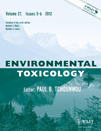
ENVIRONMENTAL TOXICOLOGY
Illuminating the Path to Safer EcosystemsENVIRONMENTAL TOXICOLOGY, published by Wiley, is a premier academic journal dedicated to the multifaceted study of toxic substances in the environment and their effects on human health and ecosystems. With the ISSN 1520-4081 and E-ISSN 1522-7278, this journal holds a prestigious position in the field, being ranked in the Q1 category across various relevant disciplines, including Health, Toxicology and Mutagenesis, and Management, Monitoring, Policy and Law. The journal regularly publishes high-quality research articles, reviews, and policy discussions aimed at understanding the implications of environmental toxins from 1980 to the present, contributing to the body of knowledge critical for the safety and sustainability of our environment. Researchers and professionals will find a treasure trove of information that not only highlights current trends and methodologies but also sets the stage for future advancements in toxicology. As a key resource, it provides valuable insights necessary for policy-making, environmental management, and public health, reinforcing its significance in the ever-evolving fields of toxicology and environmental science.

BULLETIN OF ENVIRONMENTAL CONTAMINATION AND TOXICOLOGY
Championing the fight against environmental contamination.BULLETIN OF ENVIRONMENTAL CONTAMINATION AND TOXICOLOGY, published by SPRINGER, is a pivotal journal in the fields of Environmental Science, Toxicology, and Public Health. With a strong history of dissemination since its inception in 1966, the journal predominantly focuses on the latest advances in understanding environmental contaminants and their toxicological effects on health and ecosystems. It currently holds a respectable Q2 ranking across multiple categories including Health, Toxicology and Mutagenesis, Medicine (miscellaneous), and Pollution, as per the 2023 metrics. While the journal is not Open Access, it provides an invaluable platform for researchers, professionals, and students seeking to contribute to and stay informed on critical issues regarding environmental hazards and their implications. With an engaged community of scholars and practitioners, this journal continues to be an essential resource for addressing the pressing challenges of environmental contamination and its health impacts, guiding future research and policy decisions.

TOXICOLOGY AND APPLIED PHARMACOLOGY
Pioneering Research in Toxicological ScienceTOXICOLOGY AND APPLIED PHARMACOLOGY, published by Academic Press, Inc. Elsevier Science, stands as a leading journal in the domains of toxicology and pharmacology, with its establishment dating back to 1959. With an impact factor reflecting its academic rigor and relevance, this journal is classified in the Q2 quartile for both pharmacology and toxicology categories, underscoring its significance in the scientific community. It ranks #34 out of 133 in Toxicology and #95 out of 313 in Pharmacology according to Scopus, placing it within the 74th and 69th percentiles, respectively. The journal aims to disseminate quality research that drives advancements in understanding the interactions of drugs and toxic substances within biological systems. Researchers and professionals are invited to contribute and engage with a broad spectrum of articles that cover mechanistic studies, risk assessment, and innovative therapeutic strategies. Although the journal does not offer open access, it continues to be a crucial resource for those who seek to navigate the complex interface of drugs and their toxicological implications.
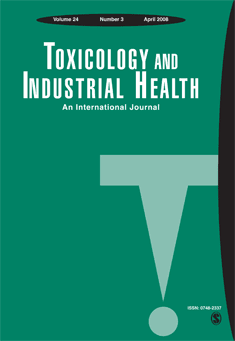
TOXICOLOGY AND INDUSTRIAL HEALTH
Innovating solutions for a healthier industrial environment.TOXICOLOGY AND INDUSTRIAL HEALTH, published by SAGE PUBLICATIONS INC, is a premier journal in the field of toxicology, public health, and environmental health, with a significant history dating back to 1985. With its ISSN 0748-2337 and E-ISSN 1477-0393, the journal provides a platform for disseminating groundbreaking research and comprehensive reviews that address the complexities of toxic substances in industrial and occupational settings. Despite its Q3 ranking among peers in health, toxicology, and public health, this journal is becoming increasingly influential, reflected in its growing citation metrics. Researchers and professionals benefit from its commitment to fostering knowledge in both theoretical and practical contexts, making it an essential resource for those dedicated to advancing understanding in this vital field. The journal's main objectives include promoting research addressing the implications of toxicology on health and safety standards across industries, ensuring accessibility to current studies for a global audience. Overall, TOXICOLOGY AND INDUSTRIAL HEALTH plays a critical role in bridging the gap between research and real-world applications, proving invaluable to students, professionals, and researchers alike in their pursuit of enhancing public health and environmental safety.